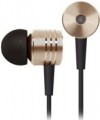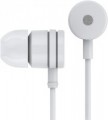Impedance
Impedance refers to the headphone's nominal resistance to AC current, such as an audio signal.
Other things being equal, a higher impedance reduces distortion, but requires a more powerful amplifier — otherwise the headphones simply will not be able to produce sufficient volume. Thus, the choice of resistance depends primarily on which signal source you plan to connect the "ears". So, for a portable gadget (smartphone, pocket player), an indicator of
16 ohms or less is considered optimal,
17 – 32 ohms is not bad. Higher values —
33 – 64 ohms and
65 – 96 ohms — will require quite powerful amplifiers, like those used in computers and televisions. And models with a resistance of
96 – 250 ohms and
above are designed mainly for Hi-End audio equipment and professional use; for such cases, detailed recommendations for selection can be found in special sources.
Sensitivity
Rated headphone sensitivity. Technically, this is the volume at which they sound when a certain standard signal from the amplifier is connected to them. Thus, sensitivity is one of the parameters that determine the overall volume of the headphones: the higher it is, the louder the sound will be with the same input signal level and other things being equal. However, we must not forget that the volume level also depends on the resistance (impedance, see above); moreover, it is worth choosing “ears” for a specific device first by impedance, and only then by sensitivity. In this case, one parameter can be compensated for by another: for example, a model with high resistance and high sensitivity can work even on a relatively weak amplifier.
As for specific figures, headphones with indicators of 100 dB or less are designed mainly for use in a quiet environment (in some similar models, the sensitivity
does not exceed 90 dB). For use on the street, in transport and other similar conditions, it is desirable to have more sensitive headphones — about
101 – 105 dB, or even
110 dB. And in some models, this figure can reach
116 – 120 dB. and even
more.
It is also worth noting that this parameter is relevant only for a wired connection according to the analogue standard — for example, via a 3.5 mm mini-
...jack. When using digital interfaces like USB and wireless channels like Bluetooth, the sound is processed in the built-in headphone converter, and if you plan to mainly use this kind of application, you can not pay much attention to sensitivity.Material
The main material used for the headphone housing.
Most modern headphones are made of plastic: it is inexpensive and at the same time practical, easy to process and well suited even for complex shapes. For such models, the case material is not indicated at all. However, there are more specific options, they can be as follows:
— Metal. The main advantages
of metal cases are high reliability and a solid appearance — which also lasts quite a long time due to the resistance of this material to scratches. In addition, metal may also be the best option in terms of acoustics. At the same time, it costs much more than plastic, and therefore it is found mainly among fairly advanced models, including Hi-Fi class.
—
Tree. Due to the characteristic colour and texture, the wood gives the headphones a pleasant and stylish appearance. In addition, it is also pleasant to the touch, and for many users, the wooden surface is associated with a “warm” and “soft” sound, which can significantly affect the subjective perception of the sound of headphones. At the same time, in reality, such a case has little effect on the sound quality, and the actual acoustic characteristics of such models may be different. Moreover, wood is rarely used in its pure form, it is usually combined with other materials — in this case, we are talking about plastic, the combination of wood and metal is placed in a separa
...te paragraph (see below).
— Wood / metal. Usually, in this case, metal cases with wooden inserts are meant. See above for details on the features of these materials. Here we note that this option is considered more advanced than the “ordinary” tree (wood with plastic), however, it costs accordingly.
— Ceramics. Headphones typically use high-quality ceramics that are durable, reliable, and with advanced acoustic characteristics. At the same time, this material is very expensive. Therefore, it is found in single models, mainly in-ear "ears" of the top class — ceramics are not suitable for large cases, because such devices would be too fragile.Weight
The total weight of the headphones; for true wireless models (see "Cable Type"), the weight of each individual earbud is listed.
This parameter is directly related to the design (see above) and some features of the functionality. Thus, the mentioned true wireless devices are very light, their weight
does not exceed 25 g. More traditional in-ears and in-ears can be noticeably heavier,
up to 50g for in-ears and up
to 100g for most in-ears. Overhead models, for the most part, are quite massive: among them there are many models weighing
200 – 250 g,
250 – 300 g and even
more than 300 g. It should be noted that a significant weight for false ears is often not a disadvantage, but an advantage: it allows them to stay on the head more securely, creates an impression of solidity and reliability, and most often does not create significant inconvenience.

